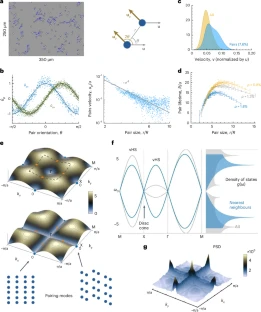Phys.org January 26, 2023
The concept of quasiparticles has become a cornerstone of condensed quantum matter, where it explains a variety of emergent many-body phenomena such as superfluidity and superconductivity. Researchers in South Korea used quasiparticles to explain the collective behaviour of a classical system of hydrodynamically interacting particles in two dimensions. In the disordered phase of this matter, measurements revealed a subpopulation of long-lived particle pairs. Modelling and simulation of the ordered crystalline phase identified the pairs as quasiparticles, emerging at the Dirac cones of the spectrum. The quasiparticles stimulated supersonic pairing avalanches, bringing about the melting of the crystal. In hexagonal crystals, where the intrinsic three-fold symmetry of the hydrodynamic interaction matches that of the crystal, the spectrum forms a flat band dense with ultra-slow, low-frequency phonons whose collective interactions induce a much sharper melting transition. Altogether, these findings demonstrate the usefulness of concepts from quantum matter theory in understanding many-body physics in classical dissipative settings…read more. TECHNICAL ARTICLE

Hydrodynamic pairing in disordered and ordered phases. Credit: Nature Physics (2023)